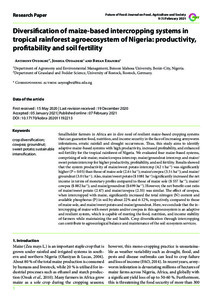| dc.date.accessioned | 2021-03-05T10:26:39Z | |
| dc.date.available | 2021-03-05T10:26:39Z | |
| dc.date.issued | 2021-02-07 | |
| dc.identifier | doi:10.17170/kobra-202011192213 | |
| dc.identifier.uri | http://hdl.handle.net/123456789/12583 | |
| dc.language.iso | eng | eng |
| dc.rights | Namensnennung 4.0 International | |
| dc.rights.uri | http://creativecommons.org/licenses/by/4.0/ | |
| dc.subject | crop diversification | eng |
| dc.subject | cowpea | eng |
| dc.subject | groundnut | eng |
| dc.subject | sweet potato | eng |
| dc.subject | Sustainable intensification | eng |
| dc.subject.ddc | 580 | |
| dc.subject.ddc | 630 | |
| dc.title | Diversification of maize-based intercropping systems in tropical rainforest agroecosystem of Nigeria: productivity, profitability and soil fertility | eng |
| dc.type | Aufsatz | |
| dcterms.abstract | Monocropping of maize is becoming unsustainable in the rainforest agroecosystem of Nigeria. This is due to the adverse impact of climate change such as increasing pests and disease infestations and erratic rainfall patterns coupled with underutilization of resources. Smallholder farmers in this tropical agroecosystems are in dire need of adaptive and resilient cropping systems to ensure food, nutrition, and livelihood security. Thus, this study aims to identify adaptive maize-based systems for the rainforest agroecology of Nigeria with high productivity, increased profitability, and enhanced soil fertility. The maize-based cropping systems comprised of maize sole; maize + cowpea; maize + groundnut; and maize + sweet potato. Results showed that the system productivity of maize + sweet potato (5.1 t ha–1) was significantly higher (P = 0.05) than maize sole (2.0 t ha–1); maize + cowpea (2.9 t ha–1); and maize + groundnut (2.5 t ha–1). Maize + sweet potato system ($ 808 ha–1) significantly increased the net income in terms of monetary profits compared to maize sole ($ 524 ha–1); maize + cowpea ($ 618 ha–1); and maize + groundnut ($ 560 ha–1). However, the net benefit-cost ratio of maize + sweet potato (1.17) and maize + cowpea (1.15) are similar. The effect of cowpea intercrop with maize affected the availability of nitrogen (N), phosphorus (P), and organic carbon (OC) in soil. The intercrops of maize + sweet potato and maize + cowpea in this agroecosystem are sustainable and adaptive intercropping systems that are capable of meeting the food requirements and income stability of farmers while maintaining the soil health. Crop diversification through intercropping in tropical smallholder farming systems can contribute to food security and maintenance of the soil ecosystem services. | eng |
| dcterms.accessRights | open access | |
| dcterms.creator | Oyeogbe, Anthony | |
| dcterms.creator | Otoadese, Joshua | |
| dcterms.creator | Ehanire, Bryan | |
| dc.subject.swd | Nigeria | ger |
| dc.subject.swd | Pflanzenbau | ger |
| dc.subject.swd | Diversifikation | ger |
| dc.subject.swd | Augenbohne | ger |
| dc.subject.swd | Mais | ger |
| dc.subject.swd | Erdnuss | ger |
| dc.subject.swd | Batate | ger |
| dc.subject.swd | Nachhaltigkeit | ger |
| dc.subject.swd | Intensivlandwirtschaft | ger |
| dc.subject.swd | Tropischer Regenwald | ger |
| dc.subject.swd | Agrarökosystem | ger |
| dc.type.version | publishedVersion | |
| dcterms.source.identifier | EISSN 2197-411X | |
| dcterms.source.issue | No. 1 | |
| dcterms.source.journal | Future of Food: Journal on Food, Agriculture & Society | eng |
| dcterms.source.volume | Vol. 9 | |
| kup.iskup | false | |
| dcterms.source.articlenumber | 328 | |


